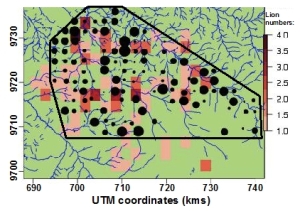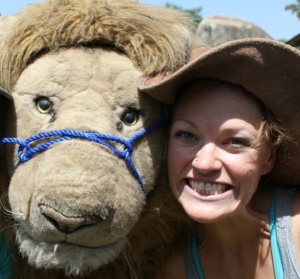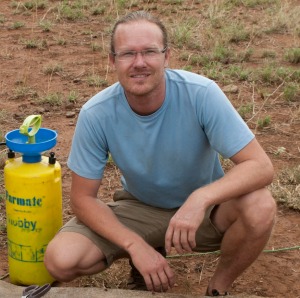Welcome to Snapshot Serengeti
Hi! And welcome to Snapshot Serengeti. We are all incredibly excited to be working with you to turn photographs into scientific discoveries. You might be wondering what this is all about, so let me start with some introductions. This is Ali:
Ali is a researcher at the University of Minnesota. She studies the big carnivores (lions, hyena, cheetahs, and leopards) in the Serengeti. Every year she flies to Tanzania, loads up on supplies in Arusha, and then drives for a day – mostly on dirt roads – out into Serengeti National Park.
Craig is a professor at the University of Minnesota and Ali’s advisor. He runs the Lion Research Center has been studying lions out in the Serengeti for decades. He has radio collars on lions in many prides, which allows him to keep track of lots individual lions over many years.
This is Daniel:
And this is Stan:
They are field assistants who work for Craig out in the Serengeti. Daniel is responsible for driving around and finding lions, while taking pictures of them and recording lots of information about what he sees. Stan is responsible for going out to the camera traps, making sure they’re still working fine, and changing the cameras’ memory cards when they fill up. Daniel and Stan live in Serengeti year-round at Lion House, where facilities are basic, but the scenery is amazing.
When Ali goes out the Serengeti, she stays at Lion House, too. Once she’s there, she makes observations that help her understand the big carnivores. A couple years ago, she installed a bunch of camera traps so she could see where the carnivores roamed when she wasn’t present. The cameras worked really well and the images were so useful that she installed some more. Now there are 225 of these cameras automatically taking pictures out the Serengeti!
My name is Margaret. This is me:

Like Ali, I’m a researcher at the University of Minnesota, and Craig is my advisor, too. Ali became inundated with the images the camera traps produced – a million per year! I have a reputation around here as a computer fundi – a Swahili word that translates as ‘master’ or ‘expert’ – and Ali asked me if there was a way to automate the process of turning images into data. See, the images by themselves aren’t that useful for research; Ali needs to know what species are in the pictures so she can do her analyses. For example, if she knows which images contain wildebeest and zebra, she can use that data put together a map that shows their density across the landscape. (The size of the circles show how many wildebeest and zebra there are in various places — bigger circles mean more wildebeest and zebra.)
 Unfortunately, I had to tell her that computers aren’t that good yet. They can’t yet reliably pick out objects from a picture, except under very controlled situations. But human eyes are remarkable in their ability to find objects in images. As I started looking through Ali’s images, I was blown away by how beautiful many of them are. And I wondered if we could ask for help from people. Lots of people. Hundreds. Thousands. So we started to think about how to do that.
Unfortunately, I had to tell her that computers aren’t that good yet. They can’t yet reliably pick out objects from a picture, except under very controlled situations. But human eyes are remarkable in their ability to find objects in images. As I started looking through Ali’s images, I was blown away by how beautiful many of them are. And I wondered if we could ask for help from people. Lots of people. Hundreds. Thousands. So we started to think about how to do that.
The end result is Snapshot Serengeti, a collaboration with Zooniverse. We’d like to ask you to help us turn all these pictures from the Serengeti into scientific data by identifying what animals are in the images and what they’re doing. And in this blog, we will keep you updated on how the project is progressing, share cool information about the Serengeti and African wildlife, as well as hopefully answer a lot of questions you may have about animal behavior, ecology, and science in general.
So, check out the camera trap images. Tell us what you see in them. And let us know if you have questions. Thanks! You can get started by clicking here.
26 responses to “Welcome to Snapshot Serengeti”
Trackbacks / Pingbacks
- - December 12, 2012









I’ve tried to follow the tutorial – but get no further than the first page of this. I have been prompted to choose ‘Antelope/deer’ from the list of animals on the right of this prompt. However, the choice of ‘antelope/deer’ is not visible to choose. Frustrating!!!
Paul, there’s a ‘Looks like’ dropdown above the list of animals.
Love this website. What a fantastic idea, and practical way to teach high school kids some aspects of environmental science. Any ideas how I can make this into an educational tool for k-12 and plan activities tied up to this website? The most obvious being tag as many pics as you can..
why doesn’t the classify work w/ mac os 10.7.5?
this is another zoo universe that does not work. what is the problem w/ this website? it does not get off the intro to classifying.
great idea
Yes, great idea, Margaret. The only thing I’ve noticed missing is the “hyrax” classification. Or are you unsure whether people would be able to distinguish between the species you’d expect to see?
I think there are quite a few of us who will be taking part in the exercise specifically in the hope of seeing one of these beautiful animals…
I’m afraid hyraxes and other small mammals don’t tend to show up in our camera trap images very often. The cameras are a few feet off the ground, and so the smaller animals don’t tend to trigger them.
Thanks for the swift reply, Margaret. Naturally I’d suggest a sub-project in rocky places or tasty-leaved trees, but I suppose you have to stick to your research objectives! 🙂
Absolutely gorgeous. I’ve spent over an hour just classifying the photos, and it’s so rewarding to get the occasional elephant, giraffe, warthog, or relaxed pride of lions!
I am happy to be of help in this project. I’d like to confirm that/if an ipad can be used to tag along, since it’s the device I have handy on the times I can collaborate on this. I took the tutorial just fine with it (ipad) but keep on getting stuck when pressing “finish” to start clasifying. Thanks!
using a macbook pro and it keeps on getting stuck when pressing “finish” to start clasifying. Thanks!
I love hearing that this work is being done at the University of Minnesota! Great work 🙂
However, I’m using a Macbook Pro with iOS Mountain lion on firefox and the finish button is unlinked! I cannot submit my classifications because the finish button does not work. Please fix, this looks like fun!
Clicking Finish after I identify something, does nothing. I continue to click and it does not go to the next capture. If I click Refresh a new capture comes up, but the previous capture is not recorded. I’ve tried Chrome and IE, both do the same.
I am really happy to help, on whatever free time I have
Wonderful Project. Excellent Website. Sorting images while listening to good Irish Music….. Now thats good for my soul.
I’m loving this! But one option I’m missing is an “I have no clue” button — I have found several photos where there was definitely SOMETHING showing, like a random paw or ear that did not allow identification at all, and I didn’t want to tick “Nothing here” because well, there was definitely an animal there. Just not identifiable to me.
Would like to help with classification but cannot get past the tutorial page. Any suggestions?
This is such a wonderful idea! 🙂 I really enjoy looking at this great photos and if while doing it I can help someone – I’m just very happy.
Loving this project! 😀 I’ve already developed ‘just one more classification’ syndrome. lol
I do agree with Megan about the need for an option to indicate where an animal is present within an image, but can’t be classified. Would be most useful 🙂
I agree too. I find it difficult if the animals are too far away. I’d like to record that there’s something there, and maybe someone with better software or more experience can identify them.
Hello, I like help with your project, I think it is a very good idea. I tried it. But I need other option too, for example – on the image is the animal, but this animal not in options, – on the image is only a part of animal, i have problem with identificantion (but it is not option nothing here).
Great fun! I hope lots of folks get involved. Needs some sort of timer like Snood so you can set yourself to play/classify only one more! I’ll be back…again and again.
Reblogged this on Alaskan Librarian and commented:
Here’s an actual introductory post to the Snapshot Serengeti project I’m playing a teensy part in as a layman classifier. It’s fun work. So much fun that the researchers have about half their photos analyzed and the project has only been live a few days.
Loved the images.
Is there a way to get a bigger copy of them? The ones I marked as “favorite”, or the ones I marked some animal?
Best regards
I just sent an email out about this site to the entire Yale Neuroscience community (I’m the administrator for the grad program) and I am totally in support of grad student research!